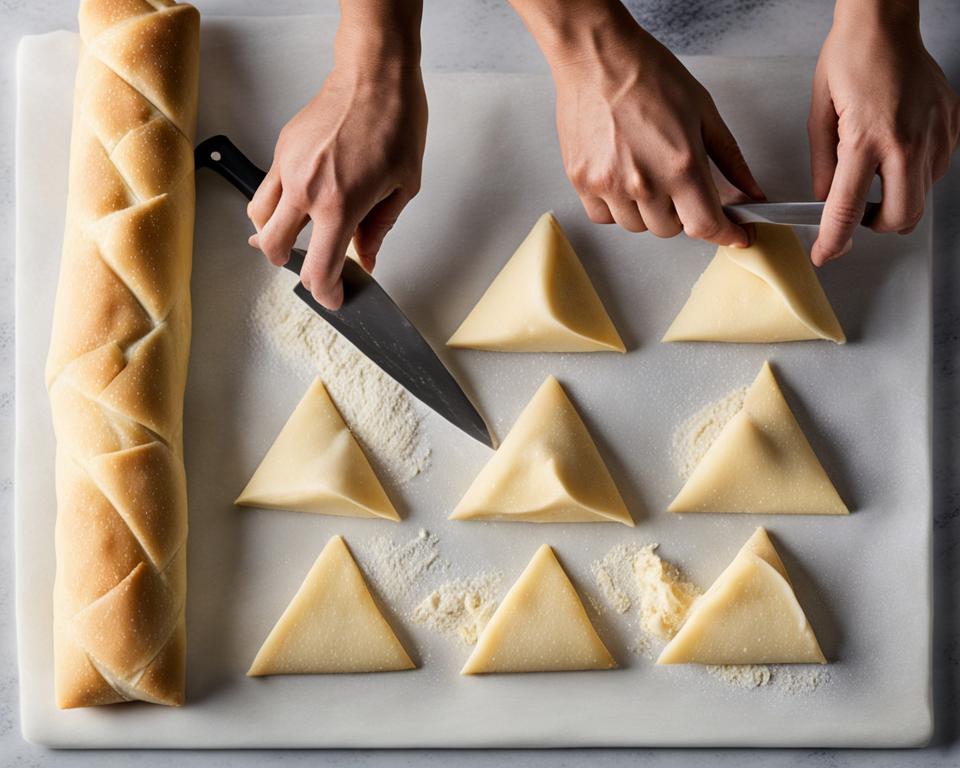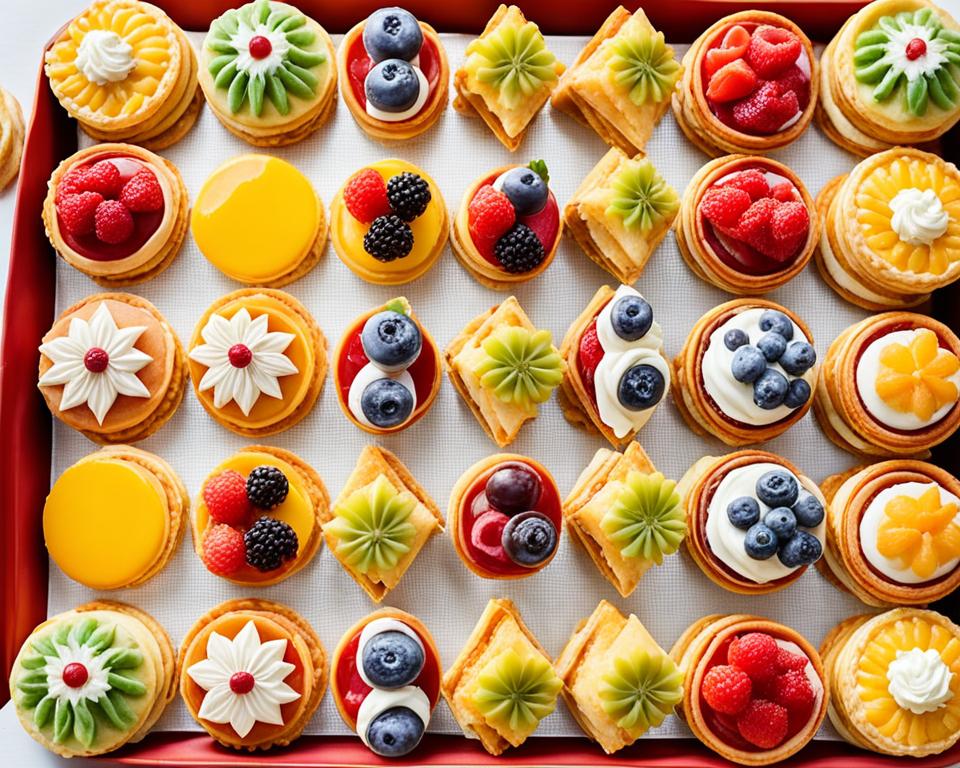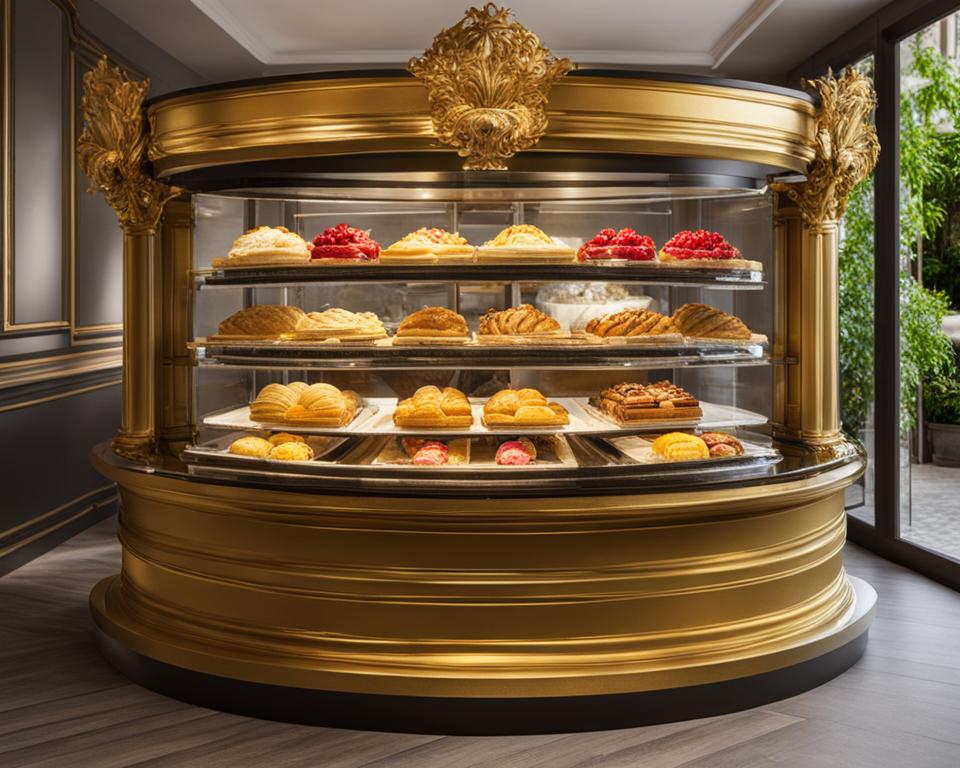The debate of what type of pastry is flaky doesn’t just tap into a baker’s repertoire; it delves into a culinary tradition cherished across kitchens – the creation of flaky pastry. This form stands as a pillar in the world of pastries, renowned for its buttery layers that transform baking into an art form. The secret behind its coveted structure lies in its preparation, where the fat – typically butter – is kept ice-cold, thus preventing premature melting and ensuring crisp, delicate layers upon baking.
Compared to its crumbly counterparts, a flaky pastry is defined by visible chunks of fat that result in an impeccably structured yet tender texture. In the vast universe of pastry recipes, it’s not merely about the blend of ingredients but the handling of them. The techniques employed are what elevate a simple dough into a flaky masterpiece that puffs into golden excellence under the oven’s warmth.
Key Takeaways
- Flaky pastry is renowned for its layered, buttery pastry texture that differentiates it from other types.
- Keeping ingredients cold is crucial in achieving the flaky characteristic, which makes for a remarkable bake.
- The irregular incorporation of fat, as opposed to a uniform blend, is key to the pastry’s flakiness.
- Flaky pastry serves as a versatile foundation for numerous pastry recipes, from pies to turnovers.
- Temperature control and technique, more so than the ingredients themselves, dictate the success of the flaky texture.
- Understanding the principles behind what type of pastry is flaky can enrich one’s baking skills and outcomes.
Understanding Flaky Pastry and Its Characteristics
Embarking on the journey of crafting flaky pastry requires a gentle hand and a respect for tradition. Beyond simply mixing butter, flour, and water, the secrets to achieving the layers of light, airy pastry lie in the methods of preparation and understanding the underlying characteristics.
The Basics of Flaky Pastry
True to its name, flaky pastry is all about achieving those buttery layers that give it a distinct texture and mouthfeel. This type of pastry dough is far from uniform; it’s characterized by noticeable fat layers, predominantly butter, which remain visible in the dough. The aim isn’t smooth perfection but rather maintaining those fat pockets that, during the baking process, contribute to the pastry’s notable lift and delicate crumb.
Flaky vs. Biscuity Pastry: A Comparison
The flaky versus biscuity pastry face-off is a matter of texture and technique. While both have their merits, a biscuity pastry yields a uniform, dense bite, achieved by fully integrating the fat into the flour. Flaky pastry, on the other hand, is about embracing irregularity. Larger chucks of butter are mixed into the dough but never fully blended. These butter lapses are exactly what create the steam during baking, leading to the flaky texture. If you’re looking for a laminated dough with precision and uniformity, flaky pastry might just change the game for you. While it’s less about the clean layers like in a croissant, those uneven pockets are what make it exceptionally tender and flaky.
The Role of Butter in Flakiness
The cornerstone of a flaky pastry’s allure comes down to one key ingredient: butter. It’s not just the quantity but the quality and temperature of butter that dictate the overall success of the pastry. A generous ratio of butter to flour is essential, as seen in the lavish layers of a laminated dough. However, the high butter ratio alone isn’t sufficient. It’s the temperature that plays a pivotal role; keeping butter chilled right up until it hits the oven ensures that the pastry will puff into its signature flakiness. Each roll and fold within baking tips is a cold embrace that promises a rich, flaky outcome. Timing, temperature, and technique are the trinity that makes or breaks the delicate structure we’re striving for.
Key Ingredients and Techniques for Perfect Flaky Pastry
Creating that quintessential flaky texture that is the hallmark of exquisite pies and tarts relies heavily on the choice of flaky pastry ingredients and the meticulous processes used during the pastry making. Here, we delve into the fundamental components and maneuvers that, when expertly applied, yield a gorgeously layered and buttery pastry.
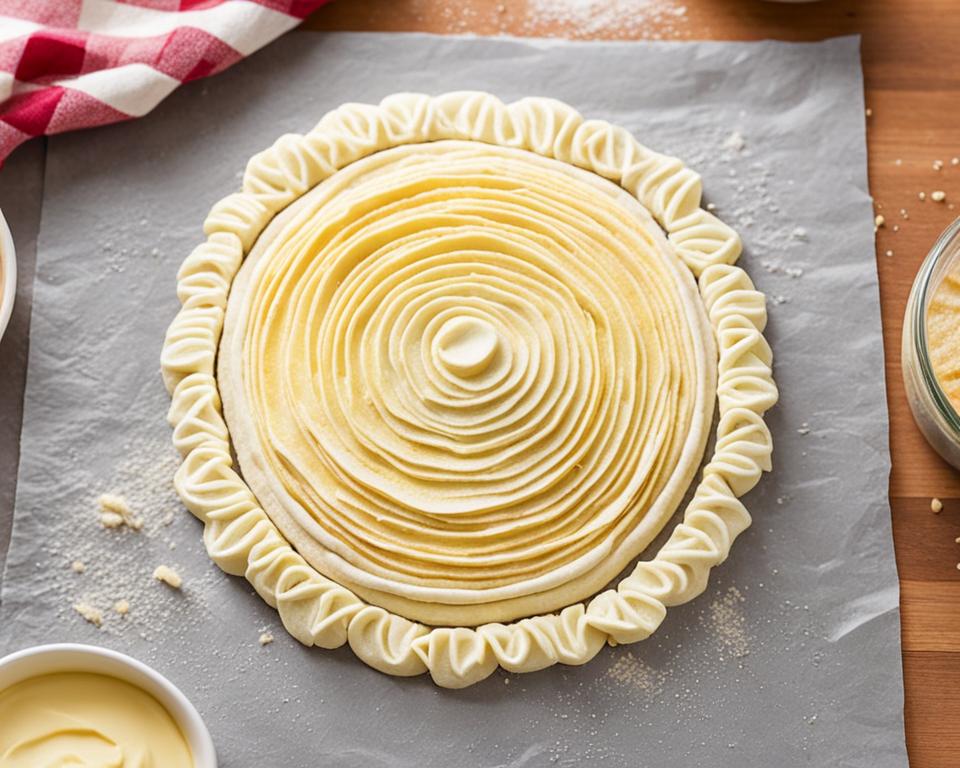
Essential Ingredients for Flakiness
To set the foundation for a mouth-watering flaky pastry, the right proportions of fat to flour are critical. The classic recipe ratio often recommended by seasoned bakers is 6 parts flour to 5 parts cold butter, which fantastically showcases the virtue of butter both in the pastry’s structure and its palatable delight. The choice of using cold butter is intentional, ensuring that the pastry is endowed with an enviable flakiness post-baking.
The Importance of Temperature in Pastry Making
When it comes to pastry making, the adage ‘keep it cool’ cannot be overstated. The imperative of temperature control is observed at every stage of the process, from the mixing of the flaky pastry ingredients to the very to the very instant the pastry hits the oven’s heat. Cold butter, in particular, must maintain its structure to interlay correctly within the flour, setting off the alchemy in the oven that results in the beloved flakiness.
Lamination Techniques for Butter Integration
Lamination is the delicate art of folding and rolling butter into the dough, a technique paramount in the world of pastries, such as croissants and puff pastry. This process, while it may sound intricate, can be simplified for the home baker without forsaking those sumptuous, crisp layers. The result is a robust dough that accommodates a myriad of fillings and shapes, all revealing that flaky goodness upon baking.
| Ingredient | Function | Characteristic |
|---|---|---|
| Flour | Structure | Foundation for lamination |
| Cold Butter | Flakiness | Large, flat pieces for steam-creation |
| Ice Water | Moisture | Minimally added for binding |
| Salt and Sugar | Flavor enhancers | Slight quantity for taste balance |
| Vodka or Alcohol (Optional) | Gluten control | Limits gluten formation and adds flavor |
As illustrated in the table, each ingredient not only contributes to the flavor profile of the flaky pastry but also plays a crucial role in achieving those perfectly puffed, buttery layers. With a respect for temperature control and an embrace of simple lamination tricks, even novice bakers can quickly become adept at creating puff pastry wonders. The beautifully orchestrated blend of these ingredients and techniques ensures that the finished pastry is not just food, but a work of art.
Step-by-Step Guide to Creating Flaky Pastry Dough
Nothing gratifies a baker more than a beautiful sheet of tender flaky pastry, ready to envelope sweet or savory fillings. With our baking guide, you will learn how to make flaky pastry with confidence. So let’s roll up our sleeves and get started on a journey that epitomizes baking pleasure.
First, you will initiate the process by combining the fundamental dry components. Precision is your ally in this step. Whisk together flour, salt, and a bit of sugar. Sugar isn’t just for taste; it’s a browning agent that will give your pastry a golden hue.
Next, introduce diced and chilled butter into your flour mixture, using your hands to ensure that each cube is fully enveloped by the dry ingredients. The temperature of the butter is vital – cold to the touch. As you incorporate the butter, flatten each piece, initiating the essential layering process that defines flaky pastry. The result should look shaggy and uneven; that’s the beauty of potential within the mixture.
Our pastry techniques emphasize the importance of keeping your ingredients as cool as possible. Thus, once you’ve introduced the butter, the entire bowl deserves a rest in the fridge or freezer, slowing down any fat softening that your hands may have initiated.
Moisture’s role is key yet conservative. Drizzle in ice water, and, if you desire, a touch of vodka or high-proof alcohol—a savvy trick to impede gluten development without sacrificing dough cohesion. Gently, use your hands to bring together a dough that balances dry with just-damp, allowing it to hold its shape without veering towards stickiness.
Resist the urge to overwork; what you want is a dough that’s a visual patchwork of butter streaks – a tapestry of fat amidst the flour, promising exquisite flakiness upon baking. It’s this rustic aesthetic that guarantees your pastry will emerge from the oven boasting those irresistible layers.
Remember, a flaky pastry isn’t synonymous with smoothness – its rough, layered visage is the precursor to baked perfection.
The final act before baking is lamination. On a floured surface, roll your dough into a large rectangle, then fold it over itself, book-style. Turn, roll, and fold again. After each fold, the dough should rest cold and composed in the chill of your refrigerator. You will repeat this act of rolling and folding a few times – each cycle promoting flakiness in your finished product.
This symphony of cold, roll, and fold is the humble foundation for countless variations – from the traditional pie to innovative tartlets, each a testament to your mastery of the flaky pastry recipe.
- Mix the dry ingredients thoroughly.
- Coat the chilled, diced butter in the flour mixture and flatten.
- Chill the mixture to maintain the butter’s temperature.
- Add liquids sparingly for binding the mixture.
- Create a dough with visible butter streaks without overworking.
- Laminate by rolling and folding, then resting the dough in the fridge.
- Embrace the dough’s ‘ugliness’ as a sign of flakiness-to-come.
Follow these steps, and you’ll have the perfect foundation for a range of baked delights that showcase the flaky, buttery layers every pastry enthusiast aspires to create.
Flaky pastry, as detailed above, is not a mystery locked within professional bakeries; it’s a technique available to anyone armed with patience and respect for the process. Mastering this dough is your entry into a world of culinary arts, where the flakiness of your creations speaks volumes of your baking prowess.
“What type of pastry is flaky?” – Recipes and Variations
In the quest to unveil the secrets of flaky pastry, two main contenders emerge: puff pastry and quick flaky pastry, often hailed for their buttery, layered texture. While traditional puff pastry is a testament to patience and skill, the quick flaky variety, or blitz pastry, offers a shortcut to the same indulgent result but in a fraction of the time. These base pastries lead to a world of culinary delights, versatile enough to carry savory meals and sweet treats alike.
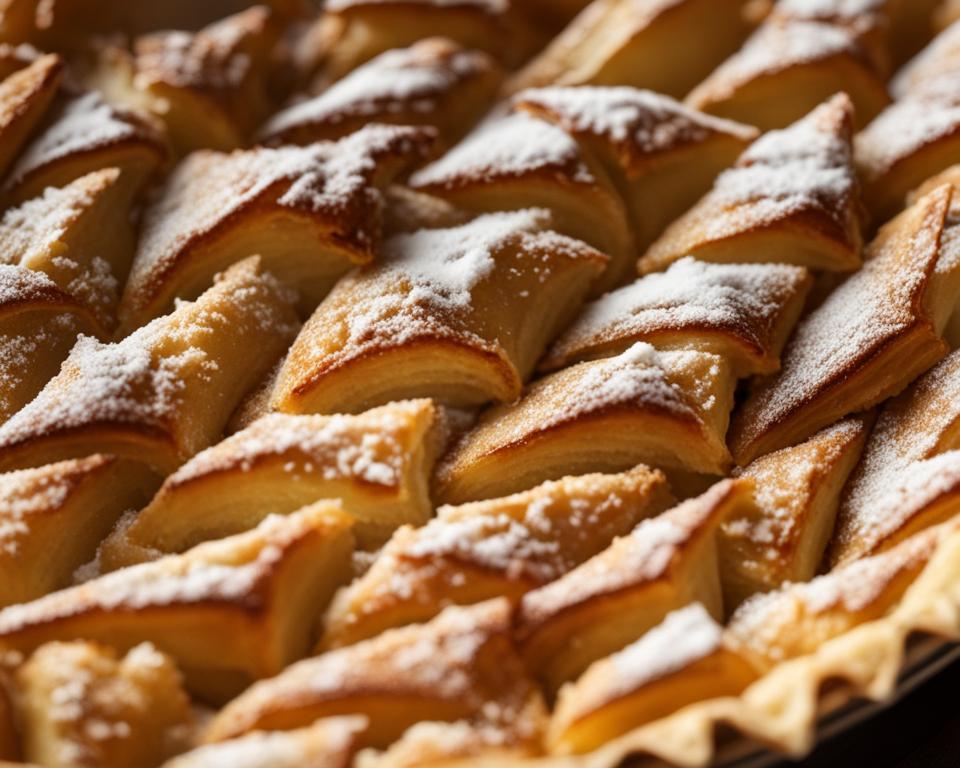
Puff Pastry vs. Quick Flaky Pastry
Known for its intricate layers, puff pastry requires a dedicated process of chilling and folding, constructing a dough that rises into numerous airy sheets. Meanwhile, quick flaky pastry, surges in popularity among home chefs for its simplified method. Without extended chilling or complex lamination, it caters to the same flaky allure while being far more accessible.
Sweet and Savory Flaky Pastry Recipes
Whether you’re in the mood for a sweet pastry filled with fruit and creams or a savory pastry enveloping meats and cheeses, the transformative nature of both puff and quick flaky pastries is unmatched. These doughs serve as a neutral canvas, welcoming a plethora of fillings and presenting a feast for creativity. The myriad of pastry recipes adopting flaky dough as their base is a testament to its enduring appeal in the culinary world.
Alterations for Dietary Restrictions
No palate need be neglected when it comes to enjoying flaky perfection. With the rising demand for dietary pastry alternatives, adaptations of classic recipes have bloomed. Gluten-free flours and plant-based fats offer viable substitutes, ensuring that the joy of a buttery, flaked bite is not lost on those with dietary restrictions. These substitutes are crafted to mimic the traditional textures and flavors, making flaky pastries inclusive and enjoyable for all.
Conclusion
The baking journey ascends to a delightful crescendo when we understand what type of pastry is flaky, with its seductive buttery pastry yields and layered aesthetic. The artistry behind such pastry recipes is a dance of temperature and texture, with the choice solid fats making a magnificent first impression, much akin to the lead in a ballet. In the realm of baking, such pastry dough stands as a marvel, with every fold and turn in its creation amounting to a symphony in the palate.
Whether one chooses the regal path of traditional puff pastry or the swift elegance of blitz pastry, each flake in the baked product is a testament to the process’s merit—the delicate, airy layers an emblem of mastery over oven and ingredients. This versatility encompasses a world of flavor whether the end result is wrapped around a sweet apple filling or a savory medley of minced meats and vegetables.
One cannot discuss flaky pastry without tipping a hat to the lamination technique. This intricate ballet of butter and dough, irrespective of it being manifested in a croissant, pie, or strudel, is what translates a common mound of ingredients into a delightful colloquy of flakes. We bow to cold temperatures here, for they ensure that our solid fats hold their ground, only melting when it’s time to perform under the oven’s spotlight, creating steam pockets that flake the pastry to perfection.
The triumph of flaky pastry begins with a cold touch and culminates in the warmth of ovens; understanding this is paramount.
With the lamination complete, the tableau of pastry dough is set for a dramatic bake. What follows is a crucial phase where the cold, rolled dough meets the intense heat, puffing into numerous layers of flaky goodness—a result that assures the baker their alchemic experiment is successful as witnessed in the crisp, fragile texture of their finished creation.
As we embrace the vast spectrum of pastry recipes before us, the versatility of flaky pastry speaks to the baker’s soul, inviting them to indulge in culinary creativity. From rustic, homely feasts to the pinnacle of fine dining delights, the potential nestled within flakiness is vast. And for those who walk the path of special dietary needs, fear not, for the world of pastry adapts, allowing everyone to savor the splendor of perfectly crisped layers. In the end, flaky pastry stands unabashed, a true confluence of art and science in the kitchen.
- Meticulously control temperatures to achieve the ideal texture.
- Select high-quality fats and maintain them in solid form for optimal lamination.
- Understand that unevenness in dough is not a defect but the promise of flaky excellence.
- Embrace the versatility of both traditional and quick pastry recipes for various culinary explorations.
- Adapt recipes to cater to all, ensuring every dinner can appreciate the flaky perfection.
May this ode to flaky pastry empower home chefs and professionals alike to craft the flakiest of layers, one butter cube, and one fold at a time. The crisp, delightful texture of your baked masterpieces will speak for themselves, securing your repute in the echelons of pastry connoisseurs.
Baking Flaky Pastry to Perfection: Tips and Tricks
Achieving the zenith of pastry dough perfection is the pursuit of any passionate baker, and when it comes to perfecting flaky pastry baking, a confluence of specific baking tips and laminated dough techniques plays a pivotal role. One of the most critical considerations is maintaining a cold environment for the pastry prior to its rendezvous with the oven. This ensures that the sizable chunks of butter, integral to creating the pastry’s layered personality, do not succumb to a premature melt.
As the flaky pastry making culminates on the baking sheet, the application of a high initial temperature is non-negotiable. It is the oven’s fervent embrace that allows the edges to crisp and the dough’s structure to set, permitting the internal steam from the melting butter to expand within its crevices, each puff augmenting the dough’s flaky character. A vigil is kept for the pastry’s journey in the oven, with careful monitoring and the readiness to adjust baking times and temperatures to attain a uniformly cooked, golden surface.
Exploration within the realm of fluids, such as the strategic inclusion of alcohol, presents yet another dimension to elevate the craftsmanship behind flaky pastry dough. Vodka, a stealthy ally, holds the potential to temper gluten development without compromising the dough’s integrity. In the grand scheme of baking, it’s a ballet of subtle hydration, precise temperature control, and informed technique. Engaging in these practices leads to gastronomic alchemy that transcends the ordinary, coaxing the layers of your laminated creation into an orchestra of textures and taste.
FAQ
What type of pastry is flaky?
Flaky pastry, also known as puff pastry, is a type of pastry that is light, buttery, and characterized by its multiple layers that puff up in the oven. It is made through a process that involves folding and rolling out dough to create thin, delicate layers.
What are the basics of flaky pastry?
The basics of flaky pastry include using a high proportion of fat to flour, maintaining cold ingredients throughout preparation, and employing a technique called lamination to fold and roll the dough for creating layers.
How does flaky pastry differ from biscuity pastry?
Flaky pastry is made with larger chunks of fat that are not fully incorporated into the dough, creating layers that puff up when baked. Biscuity pastry, on the other hand, has a more uniform texture with fat mixed throughout the dough, resulting in a crumbly and soft texture.
Why is butter important in making flaky pastry?
Butter is a key ingredient in flaky pastry because its high-fat content helps to separate the layers of the dough during baking. The water in butter also turns into steam when heated, contributing to the rising and flaking of the pastry.
What ingredients are essential for flakiness?
Essential ingredients for flakiness include flour, fat (usually butter), water, and sometimes a small amount of sugar and salt. The fat must be cold and is often layered between the flour mixture to create the flaky texture.
How important is temperature in pastry making?
Temperature control is extremely important in pastry making. It is crucial to keep all ingredients, especially butter, cold before baking to prevent the fat from melting prematurely, thus ensuring the development of flaky layers.
What are some lamination techniques for butter integration?
Lamination techniques involve repeatedly folding and rolling the dough with layers of butter in between. This can be done using simple folding for home baking or more complex methods like creating a butter block for puff pastry.
How do you create flaky pastry dough?
To create flaky pastry dough, mix the dry ingredients first, then add cold, diced butter, flattening it into flakes. Add ice water sparingly to bind the dough without over-wetting it. Lamination through folding and rolling the dough helps create layers, with chilling periods in between.
What distinguishes puff pastry from quick flaky pastry?
Puff pastry requires a time-intensive lamination process with multiple folds and chills to create its many layers. Quick flaky pastry, also known as blitz pastry, is a faster alternative where the dough is folded and rolled less meticulously and requires less resting time.
Can you provide both sweet and savory flaky pastry recipes?
Yes, flaky pastry is highly versatile and can be used for both sweet and savory recipes. From apple turnovers to cheese straws, the same flaky pastry dough can be adapted with different fillings and flavorings to suit various palates.
How can I alter flaky pastry recipes for dietary restrictions?
For those with dietary restrictions, substitutions like gluten-free flour or plant-based fats can be made. Adjusting the fat-to-flour ratio and experimenting with alternative ingredients can allow flaky pastry recipes to accommodate different dietary needs.
What are some baking tips for achieving the perfect flaky pastry?
Chill the pastry dough thoroughly before baking, use high initial oven temperatures to solidify the layers, and be ready to adjust baking times based on the pastry’s browning. Incorporating a small amount of alcohol can also inhibit gluten formation, making the dough easier to handle and flakier.

